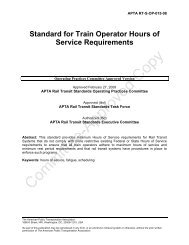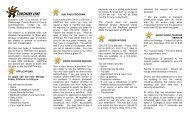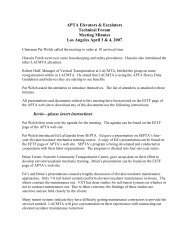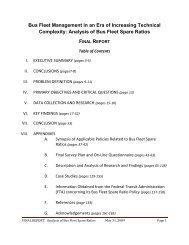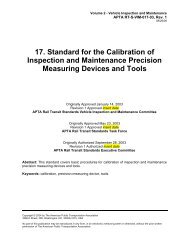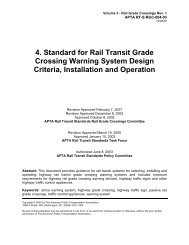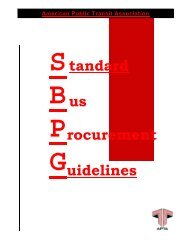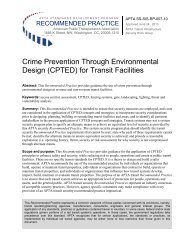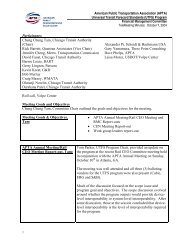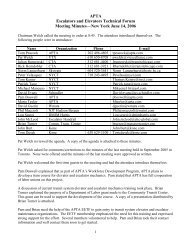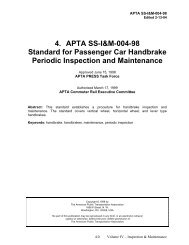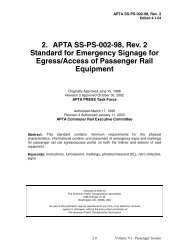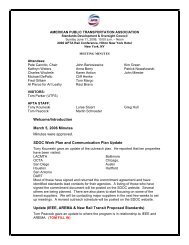Table of Contents - APTAStandards.com
Table of Contents - APTAStandards.com
Table of Contents - APTAStandards.com
You also want an ePaper? Increase the reach of your titles
YUMPU automatically turns print PDFs into web optimized ePapers that Google loves.
The “Transit Benefi t Messages”, explained in section 4.8.4.3, are another<br />
set <strong>of</strong><br />
additional messages <strong>of</strong>fered by the standard.<br />
4.8.6 Data Elements<br />
RIS Part 4 supports all the objects and data elements defined in RIS Part 3. The objects<br />
are 16 bytes and contain data elements <strong>of</strong> varying lengths. RIS Part 4 utilizes these exact<br />
objects<br />
in their “as read” and “as written” status. “As read” refers to the state <strong>of</strong> the<br />
object when it is first read from the PICC at the start <strong>of</strong> a PICC/CID transaction.<br />
Subsequently,<br />
“as written” refers to the state <strong>of</strong> the object when it is written to the PICC<br />
as a result <strong>of</strong> the transaction sequence. The ‘as read’ and ‘as written’ status <strong>of</strong> the<br />
product objects are placed together with other data elements to form the message<br />
structure that is sent from the CID through the agency<br />
<strong>com</strong>puter systems to the RCH.<br />
4.8.7 Message Sequences<br />
Act ion list messages originating from the RCH are responded with confirmation<br />
messages with separate message identifiers by AFC devices when the action directive is<br />
successfully implemented. For example, when a RCH sends the message A715, “Block<br />
a Product”, devices respond with an A416 message, “Product Blocked”, when the action<br />
succeeded.<br />
The standard does not define any other message sequences.<br />
4.8.8 Security Requirements<br />
RIS Part 4 supports transmission level data integrity through the use <strong>of</strong> MACs<br />
appended to every message. The MAC provides the<br />
RCH with the ability to validate the<br />
authenticity<br />
<strong>of</strong> transaction messages after they have been forwarded from a CID. The<br />
authenticity c heck is achieved through the secret keys stored only in CIDs and the RCH.<br />
4.8.9 Timing and Routing<br />
RIS Part 4 does not define any timing requirements.<br />
4.8.9 Usability<br />
The information provided in RIS<br />
Part 4 is <strong>of</strong>fered free <strong>of</strong> charge and can be incorporated<br />
within<br />
UTFS WP4’s efforts in order to facilitate the standardization <strong>of</strong> the interface<br />
between PICC’s host device and a Regional Clearing House (RCH). The Port Authority<br />
prohibits the licensing or charging <strong>of</strong> fees for use and development<br />
<strong>of</strong> any portion <strong>of</strong><br />
this Regional Interoperability Standard for Electronic Transit Fare Payments.<br />
Page 74



